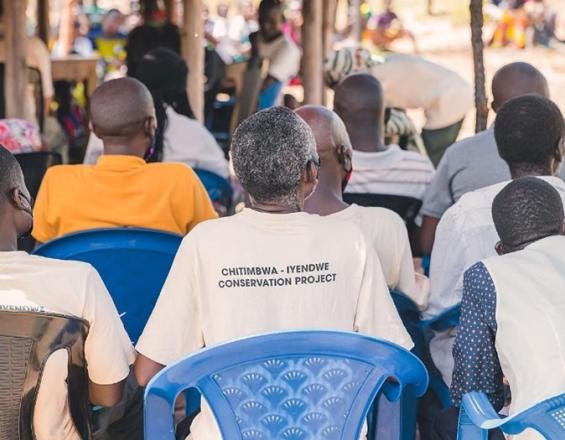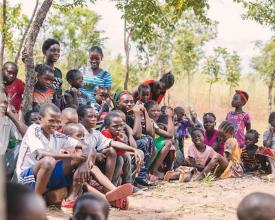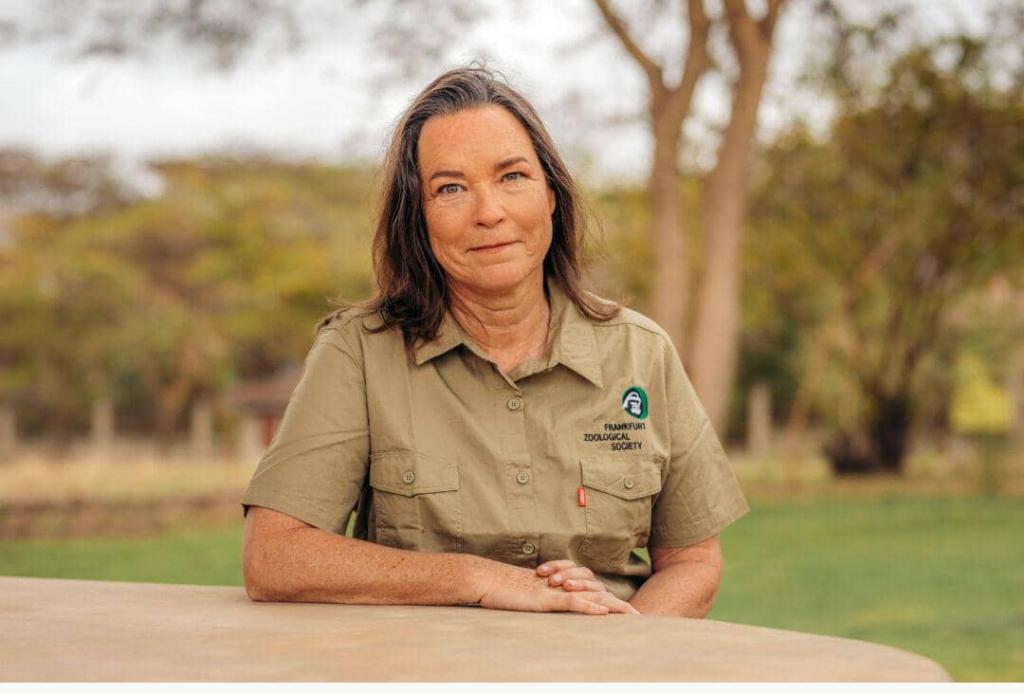Developing a community conservancy in the Iyendwe Valley

The Iyendwe Valley runs along the South-East border of Nsumbu National Park, and unlike many areas bordering a national park in Zambia, Iyendwe is not part of a Game Management Area (GMA), nor has a Community Resource Board (CRB) that manages the area. In 2020, the Nsumbu Tanganyika Conservation Programme (NTCP), a conservation partnership between the Frankfurt Zoological Society (FZS) and Zambia’s Department of National Parks and Wildlife (DNPW) and the community living around a proposed conservation area in Iyendwe committed to collaborate on the development of the Chitimbwa Iyendwe Conservation Project (CICP), to provide the community with a means of self-determination.
Alongside work to support capacity development and map out the conservation area, the NTCP supported the CICP to establish a feedback mechanism. The purpose of the feedback mechanism is to provide a transparent and efficient process for receiving, evaluating and addressing feedback raised by stakeholders related to CICP and NTCP activities and operations.
Context
Challenges addressed
- Limited avenues for feedback: Previously, there were few easy, confidential avenues to share input. The feedback mechanism ensures greater access for all voices to be heard.
- Concerns over impartiality: A response team with representatives from multiple organizations ensures unbiased review, building confidence in the process.
- Building trust and participation: By demonstrating accountability, the mechanism strengthens community buy-in, fostering long-term support for conservation efforts.
- Improving local stewardship: The mechanism allows community members to report environmental concerns, such as resource conflicts or habitat degradation, supporting better natural resource management.
- Reducing access barriers: Lock boxes in four zones ensure easy, low-cost participation, removing financial and logistical obstacles that might prevent engagement.
- Preventing conflict escalation: By addressing grievances early, the project reduces disruptions that could undermine conservation efforts.
Location
Process
Summary of the process
Trust-building and transparency are interconnected and mutually reinforcing in the feedback mechanism. Trust is the foundation for effective participation, while transparency is the means to establish and sustain that trust. By ensuring that stakeholders feel their concerns will be addressed impartially and confidentially, trust encourages active engagement. Transparency, through regular updates on grievances and actions taken, reinforces this trust, showing that feedback is not only heard but acted upon.
As trust grows, stakeholders become more confident in the process, increasing their willingness to share concerns. In turn, impartiality in handling grievances, supported by clear, open communication about outcomes, strengthens both trust and transparency.
Together, these factors create a dynamic cycle where each builds on the other, driving positive community relations and successful outcomes for long-term conservation.
Building Blocks
Building block 1 – Title * [255] Transparency with communities
The feedback mechanism increases transparency by providing a structured, accessible, and confidential way for community members to voice concerns or share feedback. With lock boxes placed in four zones, individuals can submit feedback without needing to travel or fear retaliation. A multi-organization response team ensures impartial review, demonstrating accountability and reducing perceptions of bias. Regular feedback reviews and community meetings provide updates on how concerns are addressed, reinforcing trust in the process and strengthening community confidence in conservation efforts.
Enabling factors
Transparency in the feedback mechanism is ensured through accessibility, impartiality, and accountability. Lock boxes in four zones allow confidential submissions, ensuring community voices are heard. A multi-organization response team ensures fair reviews, while regular meetings provide updates on actions taken. The project’s constitution guides decision-making, which is implemented by elected representatives at both the CICP and zonal levels, fostering trust and community ownership.
Lesson learned
Ensuring transparency in the feedback mechanism has provided key lessons that strengthen trust and accountability.
Accessibility played a crucial role, as lock boxes in four zones allowed community members to submit grievances confidentially, increasing participation.
Impartiality in reviewing the feedback was also important. Having a response team composed of multiple organizations reduces bias and reassured the community that concerns would be handled fairly.
Regular communication proved essential, with meetings providing updates on any grievances and actions taken, reinforcing trust.
A clear governance structure of the CICP and zonal committees, ensured consistency in handling feedback. Additionally, involving elected Zonal Committee representatives in oversight strengthened local ownership and legitimacy.
Trust Building
Trust-building is essential for an effective feedback mechanism, ensuring stakeholders feel safe raising concerns. Without trust, people may hesitate to report issues due to fear of retaliation or inaction, undermining the system’s purpose.
As stakeholders see their concerns addressed, trust deepens, leading to greater participation and stronger relationships between communities and conservation partners. Over time, this trust improves conflict resolution and increases local support for conservation efforts.
Enabling factors
Accessibility and confidentiality are key. Secure lock boxes in each zone allow safe, confidential submissions, encouraging participation. Impartiality is also crucial. The multi-organization response team, which includes representation from Frankfurt Zoological Society, the Chitimbwa Iyendwe Conservation Project, and Zambia’s Department of National Parks and Wildlife FZS, reassures stakeholders that feedback and grievances will be handled fairly.
Consistent communication and follow-ups further strengthen trust. Keeping complainants informed about progress and resolutions demonstrates commitment. Transparency, including sharing general grievance outcomes in meetings, reinforces confidence.
Lesson learned
Building trust in the feedback mechanism requires consistent engagement, transparency, and responsiveness. Early on, accessibility proved critical - placing lock boxes in multiple zones ensured community members could submit concerns easily and confidentially. However, initial lack of awareness limited participation, highlighting the need for repeated sensitization meetings to explain the process and reassure people of confidentiality.
Impartiality was another key lesson. By involving multiple organizations (FZS, DNPW and CICP) in the review team, the mechanism gained credibility, reducing fears of bias. Timely responses were also essential; delays in addressing grievances risked eroding confidence, emphasizing the importance of clear timelines and interim updates.
Additionally, managing expectations was necessary. Not all concerns could be resolved immediately, and some fell outside of the NTCP’s mandate. The set up of the mechanism stipulated that such issues were to be passed onto relevant bodies such as the Zambia police (no serious grievances requiring this action have been received to date). Communicating what the mechanism could and couldn’t address helped maintain trust. Ultimately, transparency, follow-through, and ongoing dialogue proved vital in ensuring the community viewed the process as fair and reliable.
Impacts
The feedback mechanism collects and addresses both grievances and positive feedback. It has strengthened community trust and participation by ensuring people feel heard and engaged in conservation efforts. With lock boxes in four zones and a confidential review process, community members can raise concerns without fear of bias or retaliation. This has improved dialogue and oversight, allowing project leaders to track sentiments and respond proactively to emerging issues.
A multi-organization response team conducts impartial reviews of the feedback. This improves accountability and transparency and reduces the potential for conflict.
By addressing grievances early, the mechanism helps to prevent conflicts over land use, resource access, and conservation policies, reducing tensions that could undermine environmental efforts. Community insights can also better feed into project design and the prioritisation of activities as per the needs and requests of stakeholders. Community members now play a more active role in decision-making, reinforcing their sense of ownership over natural resources.
Beneficiaries
- Communities living within the Iyendwe Valley.
- Traditional authority – chiefs and headmen
- The Chitimbwa Iyendwe Conservation Programme


